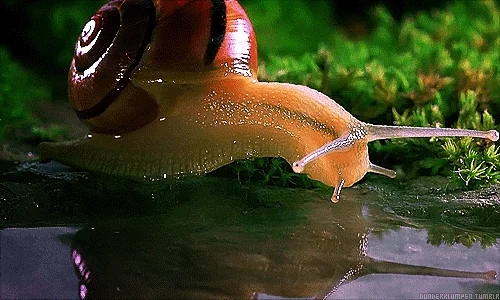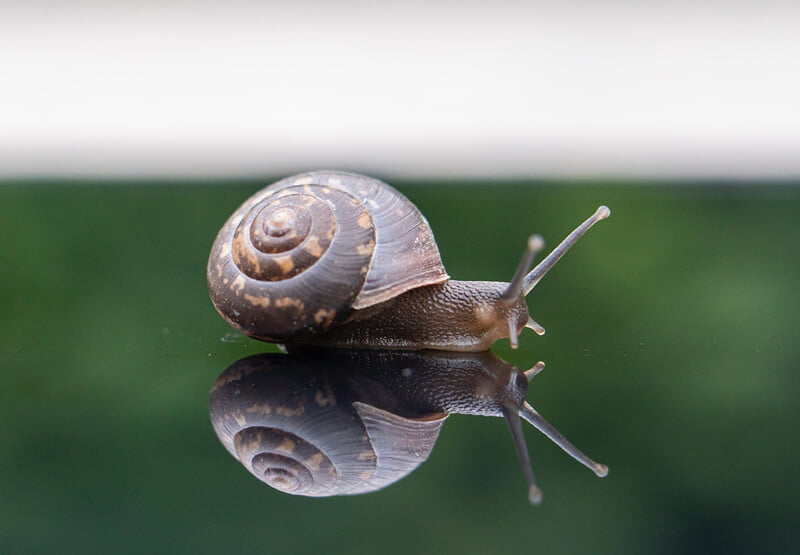“Snails” are gastropod mollusks, meaning they have a foot for crawling, and are considered a wonder of nature for their characteristics and abilities.
With a slow but sure pace, and a unique slime trail attributed with great powers for skin regeneration, this group of animals has managed to adapt to different habitats, found from the desert to the bottom of the sea, distributed all over the world.
Moreover, they are a highly valued food in many countries.
Let’s learn a bit more about this mollusk! Its characteristics, types, what snails eat, and some curiosities…
What are snails?
They are a group of small animals belonging to the gastropod mollusks, called so because they have a muscular foot to crawl and, mostly, have a spiral-shaped shell or shell, inside which they take refuge to protect themselves.

Characteristics
- Elongated body, divided into three parts: head, visceral mass, and foot.
- The head is well developed, separated from the foot by a kind of thin extension (neck), and has four tentacles: two long (upper) ones with eyes at the ends, and two short (lower) ones with olfactory and tactile functions.
- The head also features the mouth and genital opening, and they have a long, rough tongue, a buccal structure or “radula” that has tiny curved teeth (denticles) used to tear food and excavate galleries.
- The visceral mass contains the internal organs housed in the visceral sac (pouch). In their developmental stages (larval stage), the snail undergoes a process of torsion, whereby its visceral mass rotates over the foot and head.
- The foot is wide, muscular, and contains the respiratory, excretory, and digestive opening, as well as small structures that secrete a mucous substance (lubricant).
- The body is covered by a membrane (mantle) that secretes the substance forming the shell (calcium carbonate) and creates a space called “pallial cavity” by adhering to the shell and folding inwards.
- Most have a spiral-shaped shell or shell. To not lose moisture while hibernating (sleeping), they seal the entrance of their shell with a hard plate (operculum) attached to the muscular foot!
- They do not have hearing.
- The nervous system is composed of cerebral ganglia (small cords) and nerve fibers, responsible for transporting the captured signals.
- Their digestive system is complete (mouth, pharynx, esophagus, stomach, intestine, and anus).
- If the species is aquatic, it breathes through gills (plates through which water circulates) and if it is terrestrial, through lungs (organ to breathe air), although certain species have both (gills and lungs).
- Their circulatory system is open, meaning the heart transports blood or hemolymph (colorless fluid) through a network (blood sinuses) from a vein to the entire body.
- They have one or two kidneys (organs in the form of fine tubes through which they release waste).
- They have several muscles, among which the “columellar muscle,” which links the foot to the shell; they move by alternating contractions and extensions of their body.
- They have reproductive organs: male (penis) and female (vagina); some have both (hermaphrodites). Fertilization is internal and after mating, they lay eggs (from 100 to 300 eggs). Some species can have up to 12 hours of courtship!
- Average life expectancy: 10 years.
- Variable size (between 0.1 and 20 centimeters in length). There are marine species like “Syrinx aruanus” from Australia, whose shell can measure 91 cm in length!
- They are nocturnal animals, although they can be active in moist, shaded places and on rainy days.
Did you know…? Some snail species can have up to 25,000 teeth in the radula (buccal structure).
Where do snails live?
Snails are found all over the world, in terrestrial as well as marine and freshwater environments (rivers, lakes, streams…), living in sandy bottoms, at depths reaching 75 meters.
The optimal temperatures for existence vary between 15º and 20º C. In times of extreme heat, the snail enters a state of hibernation (sleep) and can last up to 4 months sleeping!
Types of snails
Depending on their habitat, snails can be classified into three types: sea snails, freshwater snails, and terrestrial snails.

Sea Snails
Live in all waters, in tropical and polar seas, from the tidal zones to the great depths. Their spiral shell has variable shapes (spherical, elongated, dish…) with bright colors.
The genus “Strombus,” or conchs, living in shallow sands stands out; with three current species: fighting conch (Strombus pugilis), winged conch (Strombus alatus), and the milky conch (Strombus gracilior).
Also, the genus “Cassis,” with large-sized conchs, like Cassis Cornuta (horned helmet), and the genus “Conus” with venomous species like the cone snail (Conus magus), famous for its powerful neurotoxins (venom).
Did you know…? The marine snail “Conus magus” fires a harpoon with over 50,000 neurotoxins (venom) to defend itself, and the probability of dying after being stung is 90%
Freshwater Snails
They inhabit rivers, lagoons, lakes, puddles, underground freshwater… and their species have been adapted to aquariums for their abilities to clean tanks, their colors, and striking shapes.
Among their representative species are: golden Inca snail (Pomacea bridgesii), Henrigirardia wienini, zebra snail (Neritina natalensis)…
Terrestrial Snails
They are the most common, also called “land or garden snails,” where they commonly inhabit, preferring moist and cool places; their spiral shell adopts rounded shapes.
Certain species are considered an undesirable pest, due to the damage they cause to crops.
Among their representative species stand out: common garden snail (Helix aspersa), giant African snail (Achatina fulica), decollate snail (Rumina decollata)…
What do snails eat?
The diet of snails depends on the habitat, type of snail, and the amount of available food. To nourish themselves, they use a long, rough tongue called “radula,” with hundreds of tiny teeth that allow them to scrape the food they are going to consume.
What do sea snails eat?
They feed mainly on plankton, organic residues, and seaweed. Certain marine species (from the genus Casis) are carnivorous and feed on echinoderms (sea cucumbers, starfish) and bivalves (clams, oysters).
What do freshwater snails eat?
Like sea snails, they prefer algae and organic residues; there are detritivorous species, that is, they consume decomposing organic matter, and others are carnivorous, feeding on other snails.
What do land or garden snails eat?
They are herbivores, and their diet includes leaves, plants, fruits, vegetables; certain species are omnivorous (they feed on both plants and animals), and eat other snails, earthworms… When they cannot find food, they can consume soil.
If you have one as a pet, you should know what newly born land snails eat; their diet is vegetable and varied, with leaves, moss, fresh plants, carrot, lettuce, pumpkin… and fruits like grapes, strawberries, and apples.
Avoid feeding them any food that contains salt or sugar as it can cause their death!
Did you know…? The land snail “Platymma tweediei” from Malaysia has a black shell and a bright red foot, so it is known as the fire snail and its appearance is truly impressive.

